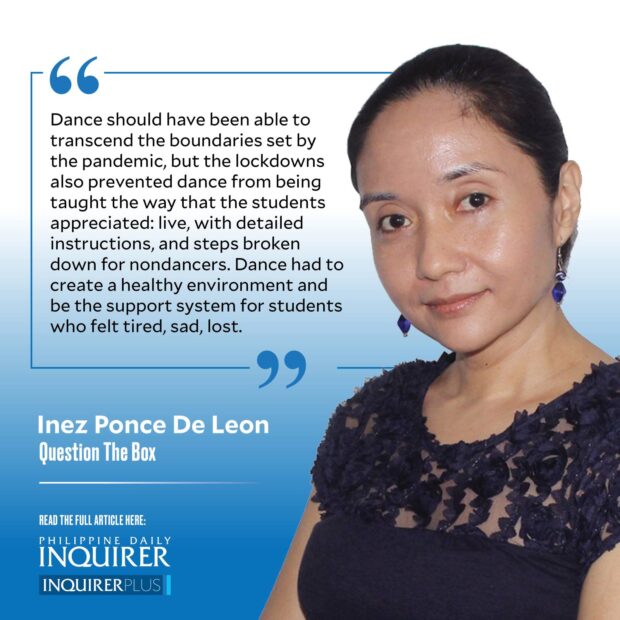Looking back, dancing forward
 DePaul University’s Global Conversations is a yearly, online event that brings together academics, students, and professionals to discuss global issues. This year, we, at the Ateneo, partnered with DePaul for a session on dance during the pandemic.
DePaul University’s Global Conversations is a yearly, online event that brings together academics, students, and professionals to discuss global issues. This year, we, at the Ateneo, partnered with DePaul for a session on dance during the pandemic.
I facilitated the Global Conversations session with professor Lin Batsheva Kahn, a modern dance instructor at DePaul; and Irish Talusan, fellow faculty member at the Ateneo’s Department of Communication. We had very few participants, but the stories about teaching and learning dance were animated, even candid.
Dance, the participants said, is cumulative, personal, and holistic. Dance should have been able to transcend the boundaries set by the pandemic, but the lockdowns also prevented dance from being taught the way that the students appreciated: live, with detailed instructions, and steps broken down for nondancers.
Dance had to create a healthy environment and be the support system for students who felt tired, sad, lost. In education research, this is often called “social presence.” Most students have a deep-seated need to seek out fellow learners, and to require the presence of a mentor to guide them, especially in times of great uncertainty.
The students had a greater appreciation for dance now, they said, because they could feel the intimacy of human contact fueling their learning and expression.
These experiences resonate with what we went through, at Ateneo’s physical education department, during our two-year hiatus from campus. We lost the ability to monitor and correct our students in real-time, so we had to innovate with videos, new activities, and more detailed course material.
For my part, I had to revise belly dance, which I’ve taught at the Ateneo since 2013.
Belly dance, contrary to those who dismiss it as mere gyrating, is a fusion of folk dances of the Middle East, North Africa, and Turkey. It requires strong posture, muscle control, strict musicality, storytelling, and stage presence. As with any dance genre, it takes years to learn and master.
During the pandemic, I had to upload videos of me dancing individual steps, document every single move, lecture about the cultures of belly dance, and repeat (on camera and in written lessons) the mantra that haunts my students’ nightmares: Feet within shoulder width! Toes forward! Knees soft! Pelvis tucked under! Shoulders down! Arms out! All this, with slow internet, low-resolution cameras, and students saddled with multiple requirements. I had to be the emotional support of many students who felt as though they had been abandoned. I could afford to meet them only an hour a week, and that time was spent listening to them groaning about their other classes while giggling about the moves they had mastered. At times, they would sigh and ask what it was like on campus; at other times, they would cheer their dancing classmates on.
When we finally returned to campus in late 2022, it took a while for my belly dance classes to regain their former joy. But as the semester moved forward, I saw the old class coming through: Students would show off their moves to their friends, giggle as they tried to control their muscles, applaud each other the way that belly dancers are taught to do when their “sisters” take to the stage.
But there, too, was something I had never seen before. The students stared at themselves in the mirror when they moved; others closed their eyes, as though they were truly listening to their bodies, and making sure that they could feel every muscle. When the students danced, they poured both grace and intensity in, as though they were feeding their stories into their movements.
Perhaps it was revenge against a pandemic that had taken away their sense of control. Now, they savored every step they pushed into the ground, every muscle contraction and expansion, the reverberating cheers of a joyful class.
There is one last thing that I teach: Belly dance is not about showing off one’s body, but matching the texture of one’s moves to the music, and using these moves to tell a story.
In their dancing, I saw my students telling their story of two years of confinement—but I also saw a continuation of centuries of women coming together, savoring their presence in space, and realizing that their strengths lie within, not in the affirmations without.
iponcedeleon@ateneo.edu
















